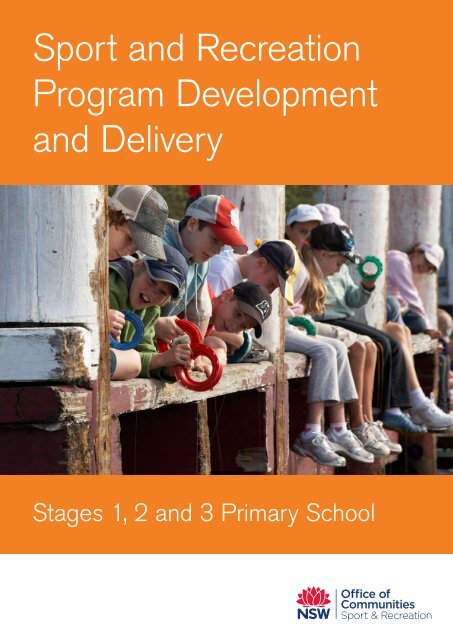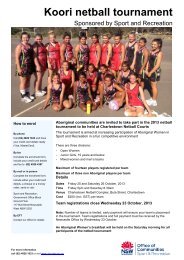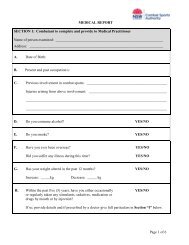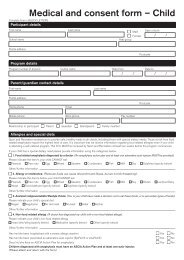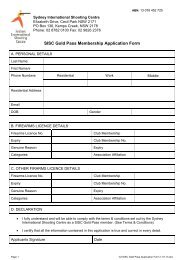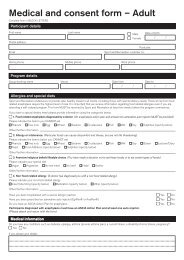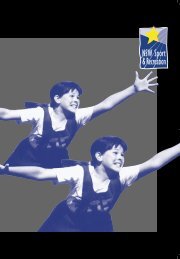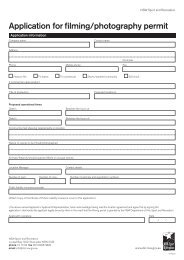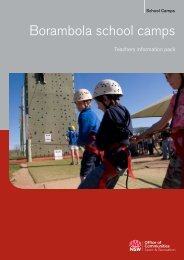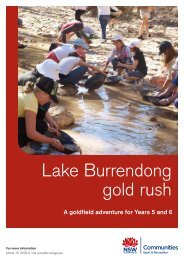Sport and Recreation Program Development and Delivery: Stages 1
Sport and Recreation Program Development and Delivery: Stages 1
Sport and Recreation Program Development and Delivery: Stages 1
- No tags were found...
You also want an ePaper? Increase the reach of your titles
YUMPU automatically turns print PDFs into web optimized ePapers that Google loves.
<strong>Sport</strong> <strong>and</strong> <strong>Recreation</strong><strong>Program</strong> <strong>Development</strong><strong>and</strong> <strong>Delivery</strong><strong>Stages</strong> 1, 2 <strong>and</strong> 3 Primary School
ContentsAbout Us 3The Purpose of this Resource 4Other Related Resources 4The Outdoor Education Experience 5Locations 5<strong>Sport</strong> <strong>and</strong> <strong>Recreation</strong> Core Values 6Risk Management 6<strong>Sport</strong> <strong>and</strong> <strong>Recreation</strong> <strong>Program</strong>s 7• <strong>Recreation</strong> <strong>Program</strong>s 7• Personal <strong>and</strong> Social <strong>Development</strong> <strong>Program</strong>s 7• Natural Environment <strong>and</strong> Heritage <strong>Program</strong>s 7Curriculum Link Reference Sheets 8• Active Living 9• Personal Health 10• Personal Challenge 11• Independence 12• Team Building 13• Connection to the Environment 14• Environmental Action 15<strong>Sport</strong> <strong>and</strong> <strong>Recreation</strong> Activities 16• Activities at Height 17• Aquatic Activities 18• Environmental Activities 19• <strong>Recreation</strong> Activities 20References 21<strong>Sport</strong> <strong>and</strong> <strong>Recreation</strong> <strong>Program</strong> <strong>Development</strong> <strong>and</strong> <strong>Delivery</strong>: <strong>Stages</strong> 1, 2 <strong>and</strong> 3 | 2 |
About us<strong>Sport</strong> <strong>and</strong> <strong>Recreation</strong> manages 11 residential facilitiesacross NSW designed primarily as outdoor education <strong>and</strong>recreation centres for school aged children. The facilities arecomfortable, well maintained <strong>and</strong> suited to both primary <strong>and</strong>high school aged students.The primary function <strong>and</strong> priority of the <strong>Sport</strong> <strong>and</strong> <strong>Recreation</strong>Centres is to provide experiential education, recreation <strong>and</strong>sporting opportunities for school aged children.<strong>Sport</strong> <strong>and</strong> <strong>Recreation</strong> programs embrace three core values:• encouraging individual Health <strong>and</strong> Wellbeing• supporting Stronger Community Cohesion• valuing the natural Environment <strong>and</strong> Cultural Heritage.In a supporting <strong>and</strong> encouraging way, programs providechildren, especially young people, with opportunities forpersonal development, learning life skills <strong>and</strong> accepting <strong>and</strong>overcoming challenges. <strong>Program</strong>s encourage children tolearn about themselves, their world <strong>and</strong> their place <strong>and</strong> rolein the community. We focus on developing many of the skillswhich will allow our youth <strong>and</strong> people generally to contributeto their communities in positive ways.Through our unique blend of facilities, programs <strong>and</strong>expertise we encourage children to enjoy the health <strong>and</strong>well-being benefits of social interaction <strong>and</strong> ongoingparticipation in sport, recreation <strong>and</strong> physical activity.You can find out more about our organisation at:www.dsr.nsw.gov.au<strong>Sport</strong> <strong>and</strong> <strong>Recreation</strong> <strong>Program</strong> <strong>Development</strong> <strong>and</strong> <strong>Delivery</strong>: <strong>Stages</strong> 1, 2 <strong>and</strong> 3 | 3 |
The purpose of this resourceThis document provides an overview of the framework thatguides the development <strong>and</strong> delivery of programs for schoolsat <strong>Sport</strong> <strong>and</strong> <strong>Recreation</strong> Centres. It provides a guide toenable educators to appreciate the value of our programs,underst<strong>and</strong> our design <strong>and</strong> development concepts, theprocess of achieving outdoor education outcomes <strong>and</strong> howthose outcomes can complement Department of Education(DEC) curriculum elements.Other related resourcesFollowing is a list of other resources designed to assist youin planning your camp experience, all of which can be foundon our website www.dsr.nsw.gov.au• Teachers Information PackageEach camp has a specific package that assists teachersin preparing for attendance at camp. The packageincludes information from what you need to know aboutcamp to how to get to camp.• School Camp Booking Request FormBooking request form allows <strong>Sport</strong> <strong>and</strong> <strong>Recreation</strong> tocollect all necessary data <strong>and</strong> begin preparing yourstudent’s program experience.• School Camps General Terms <strong>and</strong> Conditions<strong>Sport</strong> <strong>and</strong> <strong>Recreation</strong> terms <strong>and</strong> conditions provide youwith information relating to, insurance, liability <strong>and</strong> theobligations of schools at camp.<strong>Sport</strong> <strong>and</strong> <strong>Recreation</strong> <strong>Program</strong> <strong>Development</strong> <strong>and</strong> <strong>Delivery</strong>: <strong>Stages</strong> 1, 2 <strong>and</strong> 3 | 4 |
The Outdoor Education ExperienceOutdoor Education provides practical settings to support <strong>and</strong> enhance school based educational activities utilising naturalenvironments to achieve learning outcomes.Outdoor Education is an alternative to school based curriculum learning, providing outcomes which are unique to learning withinthe outdoor setting. Students embark on learning journeys through experience, adventure <strong>and</strong> challenge which encompassphysical, social, emotional, intellectual <strong>and</strong> spiritual dimensions.Growing numbers of children are losing contact with the natural environment <strong>and</strong> missing out on opportunities to experienceoutdoor play <strong>and</strong> physical activity. This lack of opportunity can be linked to heightened health problems, such as; childhoodobesity, increased stress, behaviour disorders <strong>and</strong> lower school achievement (Children <strong>and</strong> Nature Network 2009). Children canalso miss out on opportunities to use their initiative <strong>and</strong> socialise with other children.The transition from adolescence to adulthood can be facilitated <strong>and</strong> supported through experiential learning <strong>and</strong> thus recreationprograms, outdoor education <strong>and</strong> experiential learning become crucial to youth development in these times.LocationsBerryLocated on the edge of this quaint township, the Berry <strong>Sport</strong><strong>and</strong> <strong>Recreation</strong> Centre boasts a unique natural diversity thatmeans your time spent at the Centre will, at the very least, bevery Berry special.BorambolaLocated in the Riverina region of NSW, the Centre is seton the banks of the beautiful Tarcutta Creek near WaggaWagga. Whether you visit for a holiday getaway or structuredprogram, one thing is for sure – you’ll love the true countryexperience at Borambola.Broken BayTwinkle your toes s<strong>and</strong>side, take a walk on the wildside, orspot a furry friend or two on the natureside – all againstthe back drop of the big blue at the Broken Bay <strong>Sport</strong> <strong>and</strong><strong>Recreation</strong> Centre.JindabyneTake a break, improve your health <strong>and</strong> well being, <strong>and</strong>breathe the fresh mountain air. Set on 87 hectares of highalpine country, Jindabyne <strong>Sport</strong> <strong>and</strong> <strong>Recreation</strong> Centrecombines a terrific location with a wide range of facilities.Lake AinsworthThe sun <strong>and</strong> the surf are up, so you won’t have a problemgetting up <strong>and</strong> active at Lake Ainsworth <strong>Sport</strong> <strong>and</strong><strong>Recreation</strong> Centre. Nestled between Byron Bay <strong>and</strong>Ballina, this easily accessible Centre boasts an unrivalledbeachside experience.Lake BurrendongBreathtaking views are guaranteed at Lake Burrendong<strong>Sport</strong> <strong>and</strong> <strong>Recreation</strong> Centre, where the water meets thewilderness <strong>and</strong> the skies <strong>and</strong> vistas are vast. Set on a67 hectare rural property, the centre is a playground forenjoying the great outdoors.Lake KeepitFor an unforgettable rural adventure, you just can’t beatLake Keepit <strong>Sport</strong> <strong>and</strong> <strong>Recreation</strong> Centre. Nestled onthe foreshores of beautiful Lake Keepit, the Centre issurrounded by miles of pastoral <strong>and</strong> timber country <strong>and</strong> isonly 40 minutes drive from Tamworth, Australia’s countrymusic capital.Milson Isl<strong>and</strong>Visitors marvel at the tranquil atmosphere of this isl<strong>and</strong>paradise, located on the majestic Hawkesbury River. Amodern multi-purpose facility, Milson Isl<strong>and</strong> is only a shortdrive from Sydney, the Central Coast or Newcastle.Myuna BayDiscover the natural beauty of Lake Macquarie by stayinglakeside at Myuna Bay <strong>Sport</strong> <strong>and</strong> <strong>Recreation</strong>. Just a littleover an hour’s drive north of Sydney, the Centre is in aperfect location for outdoor adventure <strong>and</strong> specialises inwater-based activities all year round.Sydney AcademyThe Sydney Academy combines modern facilities with theconvenience of being close to the city, making it a must forschools, sporting <strong>and</strong> community groups <strong>and</strong> anyone lookingfor outdoor adventure <strong>and</strong> fun.Point WolstoncroftPoint Wolstoncroft’s idyllic setting on the eastern foreshoreof Lake Macquarie makes it a favourite destination for avariety of groups. You can loll lakeside <strong>and</strong> simply absorb thetranquility or enjoy the surrounds with a paddle on the greatlake or a w<strong>and</strong>er through the bushl<strong>and</strong>.<strong>Sport</strong> <strong>and</strong> <strong>Recreation</strong> <strong>Program</strong> <strong>Development</strong> <strong>and</strong> <strong>Delivery</strong>: <strong>Stages</strong> 1, 2 <strong>and</strong> 3 | 5 |
<strong>Sport</strong> <strong>and</strong> <strong>Recreation</strong> Core ValuesThe development <strong>and</strong> delivery of programs at Centres isbased on making a positive impact on an individual’s physical,social, emotional, intellectual <strong>and</strong> spiritual health <strong>and</strong> theinteractions <strong>and</strong> relationships they develop within theircommunity <strong>and</strong> environment. Our core values include:Core Value 1:Encouraging Individual Health <strong>and</strong> Well BeingPromoting <strong>and</strong> enhancing well being by:• providing opportunities to develop skills to participate inphysical activity• encouraging social interaction <strong>and</strong> team work• providing opportunities to experience decision making<strong>and</strong> the subsequent consequences• providing opportunities for experiencing the benefits ofhealthy mind <strong>and</strong> body• providing opportunities for exposure to new experiences<strong>and</strong> encouraging expansion of interest bases• providing information to continue to participate in healthylifestyle options.Core Value 2:Supporting Stronger Community CohesionEncouraging individuals to contribute to their community’sdevelopment by:• facilitating programs that are inclusive• promoting shared contribution to aspects of programse.g. dining duty, team activities etc.• promoting underst<strong>and</strong>ing <strong>and</strong> appreciation of other’spersonal differences <strong>and</strong> achievement• encouraging group achievement.Risk ManagementParticipation in outdoor pursuits carries a level of inherentrisk. It is not possible to totally eliminate risk, nor would thisbe desirable as an element of risk is required to challenge<strong>and</strong> assist students’ development. <strong>Program</strong>s are conductedin an environment that identifies <strong>and</strong> mitigates real risk.Risk Management measures incorporated intoprograms include:• routine review of policies, procedures <strong>and</strong> operations toimprove the delivery of services.• staff facilitating recreation <strong>and</strong> education sessions holdappropriate tertiary qualifications as well as current firstaid certification• specific technical qualifications are held by stafffacilitating high risk activities• annual staff in servicing ensures that skills <strong>and</strong>knowledge remain current• all staff are subjected to a Working with ChildrenCheck through the NSW Commission for Children<strong>and</strong> Young People <strong>and</strong> participate in ongoing ChildProtection training• st<strong>and</strong>ard Operating Procedures (SOPs) apply to allprogram <strong>and</strong> service delivery components includingoutdoor education <strong>and</strong> recreation activities. The SOPshave been developed to comply with Australian <strong>and</strong>International St<strong>and</strong>ards for the operation <strong>and</strong>maintenance of equipment in accordance withmanufacturer’s guidelines• all programs are evaluated on completion topromote continuous improvement in quality of service<strong>and</strong> operations.Core value 3:Valuing the Natural Environment <strong>and</strong> Cultural HeritagePromoting the value of the natural environment <strong>and</strong> culturalheritage by:• encouraging students to explore the natural environment• proving a practical environment to experience theorylearned in the classroom• incorporating energy <strong>and</strong> water saving initiatives intoprogram design <strong>and</strong> delivery• highlighting the role of natural environment in thelife cycle• encouraging better communication by limiting exposureto social mediums• valuing conservation of Centre’s <strong>and</strong> their environmentfor the future• encouraging the notion of sharing culture, values<strong>and</strong> attitudes.<strong>Sport</strong> <strong>and</strong> <strong>Recreation</strong> <strong>Program</strong> <strong>Development</strong> <strong>and</strong> <strong>Delivery</strong>: <strong>Stages</strong> 1, 2 <strong>and</strong> 3 | 6 |
<strong>Sport</strong> <strong>and</strong> <strong>Recreation</strong> <strong>Program</strong>sOutdoor education can support student outcomes such aspersonal <strong>and</strong> group development, a positive school culture<strong>and</strong> general capabilities at a deeper <strong>and</strong> more thorough levelthan other disciplines (Martin & Hewison 2009).The highest priority for <strong>Sport</strong> <strong>and</strong> <strong>Recreation</strong> Centres is tosupport the development of school aged children throughoutdoor experiential education <strong>and</strong> recreation programs.<strong>Program</strong>s have been developed to take advantage ofunique learning environments, encourage <strong>and</strong> supportstudents undertaking personal challenge, support positiveengagement within the camp community <strong>and</strong> connectionwith the natural environment.<strong>Program</strong> development <strong>and</strong> delivery is focussed on workingwith schools to help them meet the objectives they haveidentified for their students.All programs include the core components:• individuals taking personal responsibility• working as a team <strong>and</strong> contributing to common outcomes• valuing others <strong>and</strong> accepting differences• appreciating the natural environment.Three broad program themes are available to meet generaloutcome requirements. Each can be tailored to meet specificschool needs. <strong>Program</strong> Coordinators liaise with school toidentify specific issues relevant within the school community<strong>and</strong> support current school curriculum to enhance <strong>and</strong>customise programs.<strong>Recreation</strong> <strong>Program</strong>s<strong>Recreation</strong> programs provide an introduction to outdoorphysical recreation activities while incorporating the corevalues of <strong>Sport</strong> <strong>and</strong> <strong>Recreation</strong>.<strong>Recreation</strong> programs are designed to:• encourage students to participate in a range of activities• learn new skills• encourage continued participation in physical recreation• compliment school based physical recreation programs• promote fun <strong>and</strong> enjoyment• provide personal challenge.Personal <strong>and</strong> Social <strong>Development</strong> <strong>Program</strong>sPersonal <strong>and</strong> Social <strong>Development</strong> programs provide anopportunity to deliver syllabus outcomes <strong>and</strong> personal growthwhile incorporating the core values of <strong>Sport</strong> <strong>and</strong> <strong>Recreation</strong>.Personal <strong>and</strong> Social <strong>Development</strong> programs are designed to:• enable staff to work closely with students to addressissues on an intimate level• align with PDHPE <strong>and</strong> HSIE curriculum objectives• encourage positive relationships between teachers <strong>and</strong>students, benefiting the overall school culture• create atmosphere of underst<strong>and</strong>ing <strong>and</strong>shared reflection• support student learning needs in an encouraging <strong>and</strong>supportive environment• identify barriers to be faced by students <strong>and</strong> developskills to manage <strong>and</strong> overcome barriers• encourage interaction between students.Natural Environment <strong>and</strong> Heritage <strong>Program</strong>sNatural Environment <strong>and</strong> Heritage programs provide anopportunity for better awareness <strong>and</strong> appreciation of thenatural environment <strong>and</strong> heritage while incorporating thecore values of <strong>Sport</strong> <strong>and</strong> <strong>Recreation</strong>.Natural Environment <strong>and</strong> Heritage programs are designed to:• promote learning by interacting with the environment inan intimate manner• enable first h<strong>and</strong> experience in marine, bushl<strong>and</strong> oralpine environments.• promote better underst<strong>and</strong>ing of Indigenous heritageby site visits• promote the use of the experiential learning with theenvironment a key learning tool• enable the natural environment to complement <strong>and</strong>enhance classroom learning• encourage individuals to better underst<strong>and</strong> theirresponsibility to the environment <strong>and</strong> future generations• assist individuals to develop a connection <strong>and</strong>appreciation for the natural world• increase knowledge <strong>and</strong> underst<strong>and</strong>ing of therelationship between past <strong>and</strong> present cultural heritage• promote the conservation of Centres <strong>and</strong> theirenvironment for the future• promote the notion of sharing culture, values <strong>and</strong> attitudes.<strong>Sport</strong> <strong>and</strong> <strong>Recreation</strong> <strong>Program</strong> <strong>Development</strong> <strong>and</strong> <strong>Delivery</strong>: <strong>Stages</strong> 1, 2 <strong>and</strong> 3 | 7 |
Curriculum Link Reference Sheets<strong>Sport</strong> <strong>and</strong> <strong>Recreation</strong> supports the achievement of NSW School curriculum knowledge <strong>and</strong> skill outcomes. To assist schoolswith targeting curriculum learning outcomes, Curriculum Link Reference Sheets can be located from pages 9 to 15.How to use your Curriculum Reference SheetHeadingCurriculum Link Reference Sheet<strong>Sport</strong> <strong>and</strong> <strong>Recreation</strong> <strong>Program</strong> TypeStr<strong>and</strong> Focus• This section will contain information relating to the focus of this unit.Links to DET CurriculumKnowledge <strong>and</strong> Underst<strong>and</strong>ing OutcomesThis section will contain knowledge <strong>and</strong> underst<strong>and</strong>ingoutcomes from the NSW primary school curriculum targetedin this program type.<strong>Sport</strong> <strong>and</strong> <strong>Recreation</strong> Target ComponentsSkill OutcomesThis section will contain skill outcomes from the NSW primaryschool curriculum that are targeted during the activities usedto deliver the <strong>Sport</strong> <strong>and</strong> <strong>Recreation</strong> Target Components.This section will highlight the components of the NSW school curriculum outcomes that <strong>Sport</strong> <strong>and</strong> <strong>Recreation</strong> can meet duringthis type of program.Activities<strong>Sport</strong> <strong>and</strong> <strong>Recreation</strong> activities are used to enhance the learning experience. Sample activities used to facilitate the <strong>Sport</strong> <strong>and</strong><strong>Recreation</strong> outcomes for this Content Str<strong>and</strong> include:Activity SR Target DescriptionThis section will provide an examplean activity which can be delivered toachieve <strong>Sport</strong> <strong>and</strong> <strong>Recreation</strong> TargetComponents for this program type.This section defines which <strong>Sport</strong><strong>and</strong> <strong>Recreation</strong> Target Component isbeing delivered.This section will provide examples ofhow an activity can be facilitated toachieve multiple <strong>Sport</strong> <strong>and</strong> <strong>Recreation</strong>Target Components.* Some programs have been developed to contain specific program content. These programs will contain a short blurb on thecomponents of the program only.<strong>Sport</strong> <strong>and</strong> <strong>Recreation</strong> <strong>Program</strong> <strong>Development</strong> <strong>and</strong> <strong>Delivery</strong>: <strong>Stages</strong> 1, 2 <strong>and</strong> 3 | 8 |
Active LivingCurriculum Link Reference SheetStr<strong>and</strong> Focus• Active living supports adoption of activity patterns that promote well being.• Participants develop positive skills <strong>and</strong> attitudes which support active living.• Students experience a broad range of games, sports <strong>and</strong> recreational activities in an environment that fosters positivefeelings of success <strong>and</strong> enjoyment.Links to DET CurriculumKnowledge <strong>and</strong> Underst<strong>and</strong>ing OutcomesALES1.6 Develops a repertoire of physical activities in whichthey can participate.ALS1.6ALS2.6ALS3.6Participates in physical activity, recognising that itcan be both enjoyable <strong>and</strong> important for health.Discusses the relationship between regularphysical activity <strong>and</strong> health.Shows how to maintain <strong>and</strong> improve the qualityof an active lifestyle.<strong>Sport</strong> <strong>and</strong> <strong>Recreation</strong> Target ComponentsBalancing LifestylesBenefits of physical activitySkill OutcomesMOS1.4 Demonstrates maturing performance of basicmovement <strong>and</strong> compositional skills in a varietyof predictable situations.DMS2.2 Makes decisions as an individual <strong>and</strong> as agroup memberINS3.3Acts in ways that enhance the contribution of self<strong>and</strong> others in a range of cooperative situations.COS2.1 Uses a variety of ways to communicate with <strong>and</strong>within groupsParticipates in sport, games <strong>and</strong> recreation activitiesWays of being activeActivities<strong>Sport</strong> <strong>and</strong> <strong>Recreation</strong> activities are used to enhance the learning experience. Sample activities used to facilitate the <strong>Sport</strong> <strong>and</strong><strong>Recreation</strong> outcomes for this Content Str<strong>and</strong> include:Activity SR Target DescriptionBMX Bikes Participation A great introductory or intermediate bike skills activity. Participants learn aboutroad rules, riding techniques, bike maintenance <strong>and</strong> safetyBalancing LifestylesBenefits ofphysical activityWays of beingactiveThis session will be facilitated to encourage students to examine what is abalanced lifestyle <strong>and</strong> why it is important?Students will explore how participating in physical activity can improve theirgeneral health <strong>and</strong> well being.An activity that encourages participants to investigate the alternatives availableto the traditional sports, games <strong>and</strong> recreational activities.Canoeing Participation A fun team experience where participants are taught the concepts <strong>and</strong> basictechniques behind flat water canoeing.Balancing LifestylesBenefits ofphysical activityWays of beingactiveStudents will complete a series of team challenges aimed at encouragingstudents to examine what is a balanced lifestyle <strong>and</strong> why it is important?Participants engage in discussions about the benefits of physical activity in theirday to day lives.An activity that encourages participants to investigate the alternatives availableto the traditional sports, games <strong>and</strong> recreational activities.<strong>Sport</strong> <strong>and</strong> <strong>Recreation</strong> <strong>Program</strong> <strong>Development</strong> <strong>and</strong> <strong>Delivery</strong>: <strong>Stages</strong> 1, 2 <strong>and</strong> 3 | 9 |
Personal HealthCurriculum Link Reference SheetStr<strong>and</strong> Focus• Personal Health examines decisions participants make when considering lifestyle choices.• Explores issues relating to nutrition <strong>and</strong> hygiene.• Students underst<strong>and</strong> the benefits of healthy decision making <strong>and</strong> the impact on the human bodyLinks to DET CurriculumKnowledge <strong>and</strong> Underst<strong>and</strong>ing OutcomesSkill OutcomesPHES1.12 Displays basic positive health practices. PSS1.5 Draws on past experiences to solve familiarproblemsPHS1.12PHS2.12PHS3.12Recognises that positive health choices canpromote wellbeing.Discusses the factors influencing personalhealth choicesExplains the consequences of personallifestyle choices<strong>Sport</strong> <strong>and</strong> <strong>Recreation</strong> Target ComponentsPersonal healthNutritionCOS1.1INS2.3DMS3.2Healthy decision makingEnvironmental HealthCommunicates appropriately in a variety of waysMakes positive contributions in group activitiesMakes informed decisions <strong>and</strong> acceptsresponsibility for consequencesActivities<strong>Sport</strong> <strong>and</strong> <strong>Recreation</strong> activities are used to enhance the learning experience. A sample activity used to facilitate the <strong>Sport</strong> <strong>and</strong><strong>Recreation</strong> outcomes for this Content Str<strong>and</strong> is:Activity SR Target DescriptionBushcraft (Cookout) Nutrition Participants are guided through the development of a healthy meal. Fromorganising their equipment <strong>and</strong> food supplies, to preparing their meal safely overan open fire, participants will enhance their underst<strong>and</strong>ing of basic nutrition <strong>and</strong>food preparation.Healthy DecisionMakingPersonal HealthEnvironmentalHealthStudents will learn how to make healthy choices during the production of anutritious meal.Students will learn how poor personal hygiene can impact on their personalhealth. Students will be encouraged to practice <strong>and</strong> preach strong personalhealth practices.Students will explore the effect of the environment on their personal health.They will also have the opportunity to assess how interacting with theenvironment can be a positive lifestyle choice.<strong>Sport</strong> <strong>and</strong> <strong>Recreation</strong> <strong>Program</strong> <strong>Development</strong> <strong>and</strong> <strong>Delivery</strong>: <strong>Stages</strong> 1, 2 <strong>and</strong> 3 | 10 |
Personal ChallengeCurriculum Link Reference SheetStr<strong>and</strong> Focus• Provides an opportunity for participants to develop skills in the assessment <strong>and</strong> management of risk.• Develop underst<strong>and</strong>ing of the concept of positive decision making, examining the elements of both astute decisions <strong>and</strong>potential consequences.• Empowering of students to step outside their comfort zones, recognising achievement beyond personal expectations.Links to DET CurriculumKnowledge <strong>and</strong> Underst<strong>and</strong>ing OutcomesSLES1.13SLS1.13SLS2.13SLS3.13Demonstrates an emerging awareness of theconcepts of safe <strong>and</strong> unsafe living.Recognises that their safety depends on theenvironment <strong>and</strong> the behaviour of themselves<strong>and</strong> others.Discusses how safe practices promotepersonal wellbeing.Describes safe practices that are appropriate toa range of situations <strong>and</strong> environments.<strong>Sport</strong> <strong>and</strong> <strong>Recreation</strong> Target ComponentsRisk Assessment <strong>and</strong> managementDecision makingChallenge by choiceSkill OutcomesDMS3.2PSS3.5Makes informed decisions <strong>and</strong> acceptsresponsibility for consequences.Suggests, considers <strong>and</strong> selects appropriatealternatives when resolving problems.Safe living <strong>and</strong> personal safetyPersonal <strong>and</strong> emotional resilienceSelf reflection <strong>and</strong> evaluationActivities<strong>Sport</strong> <strong>and</strong> <strong>Recreation</strong> activities are used to enhance the learning experience. A sample activity used to facilitate the <strong>Sport</strong> <strong>and</strong><strong>Recreation</strong> outcomes for this Content Str<strong>and</strong> is:Activity SR Target DescriptionAbseilingChallenge byChoicePersonal <strong>and</strong>EmotionalResilience <strong>and</strong>Decision makingSelf reflection<strong>and</strong> evaluationSafe living <strong>and</strong>personal safetyRisk Assessment<strong>and</strong> managementA challenging harness activity requiring participants to make a controlleddescent of a vertical/or near vertical wall using ropes <strong>and</strong> a harness. Thisactivity places a high dem<strong>and</strong> on an individual’s physical skills <strong>and</strong> emotions.The session will enable students to explore how <strong>and</strong> why they make decisions.It will also aim to enhance peer acceptance of decisions people make.Making the decision to participate or observe is a challenging choice for aprimary school aged student. Staff will review with kids the strength in makingthe hard choices <strong>and</strong> how this is similar to future events they will face.Students will have the opportunity to reflect <strong>and</strong> evaluate on the personal <strong>and</strong>team experiences they gained during this activity.Participants will be encouraged to reflect on other ‘life experiences’ they mayface that could involve choices of equal importance or consideration. Studentswill be encouraged to think about how they will be prepared to cope with beingout of their comfort zone <strong>and</strong> make smart decisions.This activity will explore how students can assess <strong>and</strong> manage risk in relationto everyday challenges <strong>and</strong> tasks.<strong>Sport</strong> <strong>and</strong> <strong>Recreation</strong> <strong>Program</strong> <strong>Development</strong> <strong>and</strong> <strong>Delivery</strong>: <strong>Stages</strong> 1, 2 <strong>and</strong> 3 | 11 |
IndependenceCurriculum Link Reference SheetStr<strong>and</strong> Focus• Individuals are equipped with skills <strong>and</strong> strategies to effectively deal with the dem<strong>and</strong>s <strong>and</strong> challenges of everyday life.• Independence equips <strong>and</strong> enables individuals to demonstrate adaptive <strong>and</strong> positive behaviours.• Through independence programs students develop a greater underst<strong>and</strong>ing of their personal identity.Links to DET CurriculumKnowledge <strong>and</strong> Underst<strong>and</strong>ing OutcomesSkill OutcomesGDES1.9 Identifies how people grow <strong>and</strong> change. COES1.1 Expresses feelings, needs <strong>and</strong> wants inappropriate ways.IRES1.11 Identifies how individuals care for each other. COS2.1 Uses a variety of ways to communicate with<strong>and</strong> within groupsGDS2.9 Describes life changes <strong>and</strong> associated feelings. DMS2.2 Makes decisions as an individual <strong>and</strong> as agroup member.GDS3.9Explains <strong>and</strong> demonstrates strategies for dealingwith life changes.<strong>Sport</strong> <strong>and</strong> <strong>Recreation</strong> Target ComponentsDecision MakingCoping skillsGoal SettingINS1.3Develops positive relationships with peers <strong>and</strong>other people.Self esteem <strong>and</strong> self confidenceReflectionRelaxation techniquesActivities<strong>Sport</strong> <strong>and</strong> <strong>Recreation</strong> activities are used to enhance the learning experience. Sample activities used to facilitate the <strong>Sport</strong> <strong>and</strong><strong>Recreation</strong> outcomes for this Content Str<strong>and</strong> include:Activity SR Target DescriptionFishingRelaxationTechniquesParticipants will discuss the benefits of relaxation <strong>and</strong> how participating incommon recreational activities can foster a healthy lifestyle, while also enjoyinga spot of fishing.Nature Walk Reflection Participants will enjoy the opportunity to engage with their natural surroundings.Students will be given ample opportunities to reflect on their experiencesthroughout the program. Discussions will also include identification of reflectionalternatives available to after their camp experience.Rock Climbing Goal setting /Decision makingParticipants scale a vertical (or near vertical) wall using artificial climbing holdsof different shapes <strong>and</strong> sizes. Participants are required to set themselvesgoals <strong>and</strong> make decisions on how to best reach their target. Staff will facilitateconversation around the processes of decision making <strong>and</strong> goal setting, howeffectively used can be a motivating force but also if unrealistic can haveadverse impacts on performance.<strong>Sport</strong> <strong>and</strong> <strong>Recreation</strong> <strong>Program</strong> <strong>Development</strong> <strong>and</strong> <strong>Delivery</strong>: <strong>Stages</strong> 1, 2 <strong>and</strong> 3 | 12 |
Team BuildingCurriculum Link Reference SheetStr<strong>and</strong> Focus• Team Building helps individuals underst<strong>and</strong> the concepts <strong>and</strong> importance of effective team work <strong>and</strong> creating a healthyteam environment.• Participants define roles <strong>and</strong> implement strategies to develop an atmosphere of trust, confidence, energy <strong>and</strong> creativity.Links to DET CurriculumKnowledge <strong>and</strong> Underst<strong>and</strong>ing OutcomesSkill OutcomesIRES1.11 Identifies how individuals care for each other. COS2.1 Uses a variety of ways to communicate with<strong>and</strong> within groups.IRS1.11IRS2.11IRS3.11Identifies the ways in which they communicate,cooperate <strong>and</strong> care for others.Describes how relationships with a range ofpeople enhance wellbeing.Describes roles <strong>and</strong> responsibilities in developing<strong>and</strong> maintaining positive relationships.<strong>Sport</strong> <strong>and</strong> <strong>Recreation</strong> Target ComponentsInterpersonal skillsLeadership <strong>and</strong> followershipConflict resolutionDMS2.2INS3.3PSS3.5Problem solvingMakes decisions as an individual <strong>and</strong> as agroup memberActs in ways that enhance the contribution of self<strong>and</strong> others in a range of cooperative situations.Suggests, considers <strong>and</strong> selects appropriatealternatives when resolving problems.Acceptance, reliance <strong>and</strong> trust of othersPrinciples of effective team buildingActivities<strong>Sport</strong> <strong>and</strong> <strong>Recreation</strong> activities are used to enhance the learning experience. Sample activities used to facilitate the <strong>Sport</strong> <strong>and</strong><strong>Recreation</strong> outcomes for this Content Str<strong>and</strong> include:Activity SR Target DescriptionBivouacAcceptance,reliance <strong>and</strong> trust /Conflict resolutionStudents will experience the ultimate test of team work as they embark onan overnight bush experience. Participants will have to work together to setuptheir campsite, cook a healthy <strong>and</strong> tasty meal <strong>and</strong> support each otherthroughout the night.Initiatives Problem Solving A series of fun, cooperative, challenging activities in which a group ofparticipants are confronted with a specific problem to solve. These activities areusually non-competitive <strong>and</strong> are perfect for groups to develop teamwork <strong>and</strong>interaction skills.Raft BuildingPrincipals ofteam buildingAn initiative activity on water. Participants are required to work with a team todesign <strong>and</strong> construct a vessel out of items supplied. During this session, staffwill utilise teachable moments to discuss how building a team are similar tothose of building a raft.<strong>Sport</strong> <strong>and</strong> <strong>Recreation</strong> <strong>Program</strong> <strong>Development</strong> <strong>and</strong> <strong>Delivery</strong>: <strong>Stages</strong> 1, 2 <strong>and</strong> 3 | 13 |
Connection to the environmentCurriculum Link Reference SheetStr<strong>and</strong> Focus• Individuals begin to develop or further develop their appreciation for the environment.• Through establishing a positive <strong>and</strong> meaningful connection, students become receptive to the benefits of nature.• Underst<strong>and</strong>ing the role of non-urban spaces <strong>and</strong> the benefits these provide to the individual <strong>and</strong> community.Links to DET CurriculumKnowledge <strong>and</strong> Underst<strong>and</strong>ing OutcomesENES1ENS1.5ENS1.6Gathers information about natural <strong>and</strong> built environments <strong>and</strong> communicates some of the ways in which theyinteract with, <strong>and</strong> can care for, these environmentsCompares <strong>and</strong> contrasts natural <strong>and</strong> built features in their local area <strong>and</strong> the ways in which people interact withthese features.Demonstrates an underst<strong>and</strong>ing of the relationship between environments <strong>and</strong> people.<strong>Sport</strong> <strong>and</strong> <strong>Recreation</strong> Target ComponentsEngaging in outdoor activitiesAppreciation for the environmentPersonal <strong>and</strong> group reflectionEstablishing comfort with the natural environmentLocal heritageRelationships within environmentActivities<strong>Sport</strong> <strong>and</strong> <strong>Recreation</strong> activities are used to enhance the learning experience. Sample activities used to facilitate the <strong>Sport</strong> <strong>and</strong><strong>Recreation</strong> outcomes for this Content Str<strong>and</strong> include:Activity SR Target DescriptionBivouacEnvironmentalAwarenessComfort in thenatural environment/heritageAppreciation for theenvironmentParticipants get back to being one with nature; they’ll have the opportunity tolearn about the local regions heritage while also reflecting on the relationshipbetween man <strong>and</strong> nature.Students will participate in a variety of activities aimed at allowing them toimmerse themselves in nature. Activities may include bushwalking <strong>and</strong> games.<strong>Sport</strong> <strong>and</strong> <strong>Recreation</strong> <strong>Program</strong> <strong>Development</strong> <strong>and</strong> <strong>Delivery</strong>: <strong>Stages</strong> 1, 2 <strong>and</strong> 3 | 14 |
Environmental ActionCurriculum Link Reference SheetStr<strong>and</strong> Focus• Environmental action challenges students to consider <strong>and</strong> underst<strong>and</strong> their impact on nature• Students engage in problem solving concepts <strong>and</strong> approaches to prevent environmental degradation.Links to DET CurriculumKnowledge <strong>and</strong> Underst<strong>and</strong>ing OutcomesENS1.6ENS2.6SSS3.7ENS3.5Demonstrates an underst<strong>and</strong>ing of the relationship between environments <strong>and</strong> people.Describes people’s interactions with environments <strong>and</strong> identifies responsible ways of interacting with environments.Describes how Australian people, systems <strong>and</strong> communities are globally interconnected <strong>and</strong> recognisesglobal responsibilities.Demonstrates an underst<strong>and</strong>ing of the interconnectedness between Australia <strong>and</strong> global environments <strong>and</strong> howindividuals <strong>and</strong> groups can act in an ecologically responsible manner.<strong>Sport</strong> <strong>and</strong> <strong>Recreation</strong> Target ComponentsEnvironmental impactLeave no trace principalsSustainable livingCommunity involvementProtection of the environmentActivities<strong>Sport</strong> <strong>and</strong> <strong>Recreation</strong> activities are used to enhance the learning experience. Sample activities used to facilitate the <strong>Sport</strong> <strong>and</strong><strong>Recreation</strong> outcomes for this Content Str<strong>and</strong> include:Activity SR Target DescriptionBushcraft (Cookout)EnvironmentalAwarenessEnvironmentalImpact <strong>and</strong> Leaveno traceSustainableliving, Communityinvolvement <strong>and</strong>Protection of theenvironmentParticipants will have the opportunity to walk to a campsite <strong>and</strong> prepare a mealwhile learning <strong>and</strong> implementing a variety of minimal impact principles.Students will participate in a variety of activities aimed at allowing them toimmerse themselves in nature. During the activities discussion will be hadrelating to how human kind can support a sustainable environment.<strong>Sport</strong> <strong>and</strong> <strong>Recreation</strong> <strong>Program</strong> <strong>Development</strong> <strong>and</strong> <strong>Delivery</strong>: <strong>Stages</strong> 1, 2 <strong>and</strong> 3 | 15 |
<strong>Sport</strong> <strong>and</strong> <strong>Recreation</strong> Activities<strong>Sport</strong> <strong>and</strong> <strong>Recreation</strong> Centres facilitate Outdoor Education <strong>and</strong> <strong>Recreation</strong> activities that target client outcomes <strong>and</strong> objectives.When delivering activity sessions, staff facilitate specifically to meet the target objectives of each group, as well as catering foreach individual needs <strong>and</strong> abilities.There are four key activity clusters available at <strong>Sport</strong> <strong>and</strong> <strong>Recreation</strong> Centres including:• activities at Height• aquatic• environmental• recreational.The following Activity Reference Sheets provide an overview of which activities are suitable for each curriculum outcome, as wellas identifying age restrictions <strong>and</strong> other useful information.The Activity Matrix provides you with information relating to which activities are available at each centre.<strong>Sport</strong> <strong>and</strong> <strong>Recreation</strong> <strong>Program</strong> <strong>Development</strong> <strong>and</strong> <strong>Delivery</strong>: <strong>Stages</strong> 1, 2 <strong>and</strong> 3 | 16 |
Activities at HeightActivity Information CardActivities at height encourage students to explore, challenge <strong>and</strong> underst<strong>and</strong> their personal limits in a safe <strong>and</strong> supportiveenvironment. Students are required to physically, emotionally <strong>and</strong> socially support others through their pursuit of personal challenge.Activities at height are a great way of teaching students about goal setting, decision making <strong>and</strong> resilience, while also developingtheir communication <strong>and</strong> teamwork capabilities.<strong>Sport</strong> <strong>and</strong> <strong>Recreation</strong> activities vary from location to location, the table below outlines the minimum age requirements <strong>and</strong> availabilityfor each at height activity.BerryBorambolaBroken BayLake AinsworthLakeBurrendongAbseiling• • • • • • •Climbing• • • • • • • • • • •Flying Fox/Cable Glide• • • • • • • • •Giant Swing• • • • • •Possum Run• •High Ropes• • • • • • • • • •JindabyneLake KeepitMilson Isl<strong>and</strong>Myuna BayPoint WolstoncroftSydney Academy<strong>Sport</strong> <strong>and</strong> <strong>Recreation</strong> <strong>Program</strong> <strong>Development</strong> <strong>and</strong> <strong>Delivery</strong>: <strong>Stages</strong> 1, 2 <strong>and</strong> 3 | 17 |
Aquatic ActivitiesActivity Information Card<strong>Sport</strong> <strong>and</strong> <strong>Recreation</strong> provides an introduction to a variety of aquatic activities. Students will have the opportunity to learn new skills,water confidence <strong>and</strong> water safety.Aquatic activities are a great way for students to challenge themselves in a safe <strong>and</strong> secure environment, while also developing teamwork <strong>and</strong> initiative skills. Aquatic activities also allow students to have close interaction with the natural environment <strong>and</strong> explore howwe can reduce negative human impact.<strong>Sport</strong> <strong>and</strong> <strong>Recreation</strong> activities vary from location to location, the table below outlines the minimum age requirements <strong>and</strong> availabilityfor each aquatic activity.BerryBorambolaBroken BayLake AinsworthLakeBurrendongCanoeing• • • • • • • • • •Dragon Boating• •Kayaking• • • • • • • • • •Raft Building• • • • • • • • • • •Sailing• • • • •Sea Kayaking•Surf Skis•Water Games• • • • • • • • •Water Safety• •JindabyneLake KeepitMilson Isl<strong>and</strong>Myuna BayPoint WolstoncroftSydney Academy<strong>Sport</strong> <strong>and</strong> <strong>Recreation</strong> <strong>Program</strong> <strong>Development</strong> <strong>and</strong> <strong>Delivery</strong>: <strong>Stages</strong> 1, 2 <strong>and</strong> 3 | 18 |
Environmental ActivitiesActivity Information CardEnvironmental activities are a great way for students to develop their appreciation for the environment <strong>and</strong> how society can preventenvironmental degradation.<strong>Sport</strong> <strong>and</strong> <strong>Recreation</strong> activities vary from location to location, the table below outlines the minimum age requirements <strong>and</strong> availabilityfor each environmental activity.BerryBorambolaBroken BayLake AinsworthLakeBurrendongBivouac• • • • • • • • •Cookout• • • • • • • • • • •Expedition• • • • •Marine Studies• • •Nature Walk• • • • • • • • • • •Orienteering/Rogaining/Geocaching• • • • • • • • • • •JindabyneLake KeepitMilson Isl<strong>and</strong>Myuna BayPoint WolstoncroftSydney Academy<strong>Sport</strong> <strong>and</strong> <strong>Recreation</strong> <strong>Program</strong> <strong>Development</strong> <strong>and</strong> <strong>Delivery</strong>: <strong>Stages</strong> 1, 2 <strong>and</strong> 3 | 19 |
<strong>Recreation</strong> ActivitiesActivity Information Card<strong>Recreation</strong> activities focus on improving student’s individual well-being, developing group cohesion <strong>and</strong> building relationships.<strong>Recreation</strong> Activities also encourage students to participate in fun physical activities <strong>and</strong> learn new skills.<strong>Sport</strong> <strong>and</strong> <strong>Recreation</strong> activities vary from location to location, the table below outlines the minimum age requirements <strong>and</strong> availabilityfor each recreation activity.BerryBorambolaBroken BayLake AinsworthLakeBurrendongArchery• • • • • • • • • • •Aussie <strong>Sport</strong>s• • • • • • • • •Beach Games• • •Bikes• • • • • • •Craft• • • •Dance• • • • • • • • • • •Dark Maze•Fencing• • • • • •Fishing• • • • • • • •Grass Skiing•Horse Riding•Indigenous Games<strong>and</strong> Boomerangs • • • • • • • •Initiatives• • • • • • • • • • •Low Ropes• • • • • • • • • • •Paint Ball Combat• •Parachute Games<strong>and</strong> Earth Ball • • • • •JindabyneLake KeepitMilson Isl<strong>and</strong>Myuna BayPoint WolstoncroftSydney Academy<strong>Sport</strong> <strong>and</strong> <strong>Recreation</strong> <strong>Program</strong> <strong>Development</strong> <strong>and</strong> <strong>Delivery</strong>: <strong>Stages</strong> 1, 2 <strong>and</strong> 3 | 20 |
ReferencesChildren <strong>and</strong> Nature Network – A Report on the Movement to Reconnect Children to the Natural World 2009www.children<strong>and</strong>nature.org/downloads/CNNMovement2009.pdf.Communities NSW Annual Report 2009/2010Commercial Services Directorate – Business Plan 2008 – 2011Georgakis, S & Light, R. The Outdoor Classroom: School camping as education in NSW 1890-1960’s. Australian Journal ofOutdoor Education Vol 14, #1 2010.Martin, P & Hewison, T Student Outcomes – The Place of Outdoor Education as a Core Discipline in the National Curriculum2009. Outdoor Education AustraliaNSW State Plan 2010www.outwardbound.com.au – accessed 7/3/2011www.scouts.com.au – accessed 7/3/2011Witt, Peter & Caldwell, L The Rationale for <strong>Recreation</strong> Services for Youth: An Evidenced Based Approach 2010 National<strong>Recreation</strong> <strong>and</strong> Park Association.Natural Learning Initiative – www.naturalearning.orgNSW Board of Studies Physical <strong>and</strong> Health Education Syllabus http://k6.boardofstudies.nsw.edu.au – accessed 31/10/2011Louv, Richard Last Child in the Woods: saving our Children from Nature Deficit Disorderwww.lnt.org.au/index.html – Leave No Trace websiteWater Safety Guidelines for Unstructured Aquatic Activity<strong>Sport</strong> <strong>and</strong> <strong>Recreation</strong> <strong>Program</strong> <strong>Development</strong> <strong>and</strong> <strong>Delivery</strong>: <strong>Stages</strong> 1, 2 <strong>and</strong> 3 | 21 |


